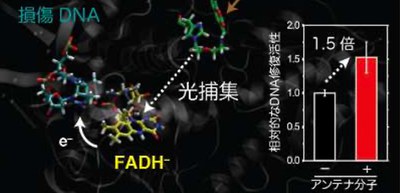
Future applications of optogenetics: DNA repair capacity enhanced by light-harvesting chromophores
A group of researchers from Osaka University and RIKEN has improved the capacity of photolyases (PLs), flavoproteins that repair DNA damaged by UV using blue light photons in sunlight just like the light-harvesting process of photosynthesis.
The chemical structure of a DNA molecule, which carries genetic information, changes by various environmental factors, contributing to mutagenesis and the development of cancer. Repairing a damaged DNA to its normal state is vital to maintain cellular homeostasis and genetic diseases such as DNA repair-deficiency disorder cause genetic diseases and mortality.
All organisms other than mammals have photoreactivation, a mechanism in which light-driven DNA repair enzyme photolyase uses blue light as a source of energy to repair UV- induced DNA damage. Although humans don't have photoreactivation, if light-activated enzymes could be used, they could be applied to therapy for treating genetic diseases. However, since light-activated enzymes require blue light, whose penetration power is so low that it is difficult to control from outside the body, these enzymes’ effects on living organisms are limited.
The catalytic DNA repair by DNA PLs requires light-driven electron transfer from the excited state of fully reduced flavin adenine dinucleotide (FADH−) to the lesions, inducing the structural rearrangement to the intact nucleobases. Although the catalytic reaction of PLs exclusively relies on the FADH− excitation by blue light, living tissues are poorly permeable to blue light. To gain photoreception ability, some PLs utilize secondary auxiliary chromophores that absorb blue light much more strongly than FADH−. As the secondary chromophores harvest photon energy for the catalytic reaction, they are called light-harvesting chromophores or antenna chromophores.
In this study, the researchers covalently and site-specifically attached a synthetic chromophore (synthetic fluorophore) to the surface of PL and successfully enhanced its enzymatic activity in light-driven DNA repair. They evaluated the DNA repair ability of PL bearing an artificial chromophore, identifying the binding site that harvests photons in sunlight efficiently.
Currently, even if PL genes are expressed in humans, light-harvesting proteins will not be produced and thus will not enhance DNA repair efficiency. However, if photoreception ability and DNA repair ability are gained by artificial light-harvesting chromophores, PL genes can be applied to humans.
As this study showed, if artificial DNA repair enzymes with high blue light-harvesting ability can be obtained by introducing functional chromophores, that will develop artificial enzymes that ensure more efficient DNA repair and repair response using different wavelengths of light. If this idea is achieved by introducing not artificial chromophores, but fluorescence proteins, it will be applied to optogenetic gene therapies for intractable genetic disorders due to defective DNA repair.
FIgure 1
The article, “Enhanced DNA repair by DNA photolyase bearing an artificial light-harvesting chromophore”, will be published in Nucleic Acids Research at DOI: https://doi.org/10.1093/nar/gkaa719.
